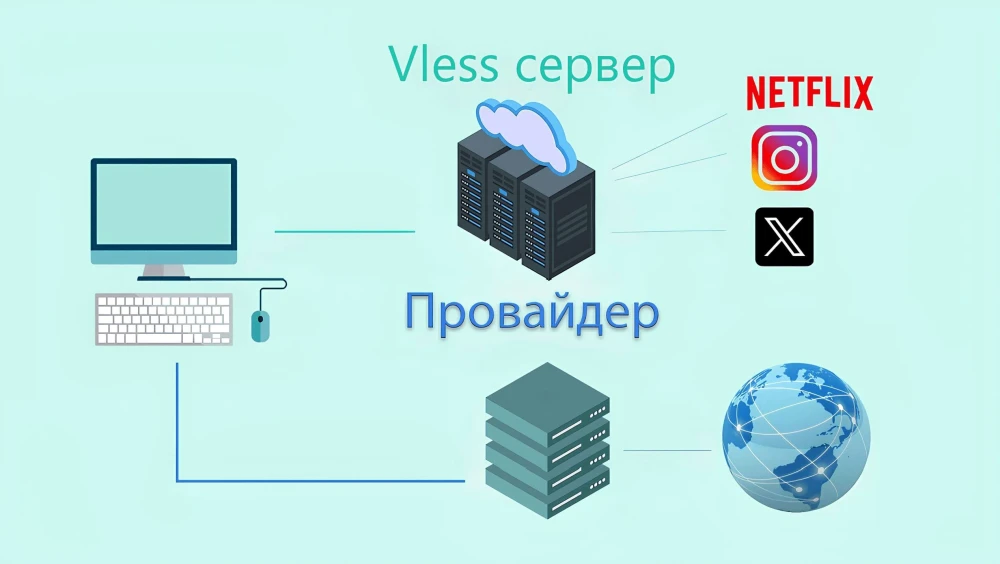Vless vs Vmess: Complete overview of protocols, their differences and security
14.09.2025

In today's digital world, concerns about privacy and reliable access to network resources are becoming increasingly important. Users are paying more attention to data transfer protocols that can increase connection speed, enhance protection, and optimize internet interaction. Among these technologies, Vless and Vmess stand out as two popular protocols used in network connectivity that provide a modern level of stability and security.
These technologies are actively discussed by specialists and enthusiasts as they offer flexible configuration and operational capabilities. To determine which one is right for you, it's important to understand their history, working features, advantages, and key differences.
History of Vless and Vmess
The Vmess protocol was one of the first to appear within the V2Ray ecosystem—a multifunctional tool for organizing network connections. Vmess was created as a universal solution for working with encrypted connections and protecting data from third-party interference. Its main idea was to balance speed, reliability, and flexibility of use.
Over time, it became clear that protocols needed simplification and modernization. Thus emerged Vless—a lighter and updated version. Vless was developed to eliminate some limitations of its predecessor, simplify the connection structure, and increase compatibility with new technologies. Thus, the history of these protocols is closely tied to the evolution of approaches to security and comfort in network operations.
Features of Vless and Vmess Protocols
The main feature of Vmess is that it uses its own authentication format and built-in encryption algorithms. This makes it convenient to use but adds some complexity to configuration.
Vless, on the other hand, was designed as a "lightweight" protocol. It removed built-in encryption, leaving only authentication. This approach increased data transfer speed and made the protocol more flexible. When necessary, users can choose their own encryption methods and additional security mechanisms.
Both technologies offer high performance, but the choice between them depends on specific tasks: Vmess is suitable for standard scenarios, while Vless is for those who want maximum flexibility and control.
Advantages
Using Vless and Vmess protocols offers several advantages:
- Operational Speed. Both protocols are optimized for high performance. This is especially noticeable in Vless, where the absence of built-in encryption reduces system load.
- Flexibility. Vless provides users with more options for selecting and configuring parameters, making it convenient for professionals.
- Broad Compatibility. Both protocols are supported by numerous applications and tools, making them universal.
- Connection Stability. Regardless of working conditions, the protocols demonstrate a high level of resilience.
Thus, the advantages of Vless and Vmess allow every user to find a solution tailored to their individual needs.
Security of VLESS and VMess: How reliable are they?
Security is always a primary concern. Vmess was initially developed with an emphasis on built-in encryption mechanisms. This is convenient as it requires no additional configuration: users get protection "out of the box."
With Vless, the situation is somewhat different. The protocol itself doesn't encrypt data, but this doesn't make it less secure. It provides the ability to integrate external security algorithms such as TLS or other modern encryption technologies. Thus, the security level directly depends on how the system is organized.
Overall, both protocols can be considered reliable. The choice depends on whether the user needs a ready-made solution or prefers to flexibly manage all security parameters.

Similarities and differences between VLESS and VMess
Despite their common foundation, Vless and Vmess protocols have both similarities and differences:
Similarities:
- High performance and operational speed
- Support within the V2Ray ecosystem
- Suitable for various use cases
Differences:
- Vmess has built-in encryption, Vless does not
- Vless is lighter and faster due to its simplified structure
- Vmess is easier to configure for beginners, Vless is more suited for advanced users
These differences allow for a flexible approach to selection and enable users to utilize the protocols exactly as needed for their specific requirements.
Relevance of Vless and Vmess
Today, Vless and Vmess protocols remain in demand due to their versatility and modern approach. As the number of internet users grows, so does the need for reliable, fast, and flexible network tools.
Vmess continues to be used as a proven and stable solution, while Vless is increasingly being implemented thanks to its lightness and modern design. Together, they form a reliable foundation for those who value speed, security, and convenience.
Trends show that Vless is gradually becoming more popular among professionals, but Vmess remains in demand among a wide range of users who value simplicity and ready-made solutions.
Conclusion
Vless and Vmess protocols are not just data transfer technologies but important tools for the modern internet. Each has its strengths: Vmess is a time-tested solution with a ready set of features, while Vless is a flexible and lightweight option that provides more freedom in configuration.
The choice between them depends on specific goals: beginners might find Vmess easier to use, while professionals will appreciate Vless's potential. In any case, both protocols provide a high level of quality, security, and stability, making them relevant and in demand in the digital age.